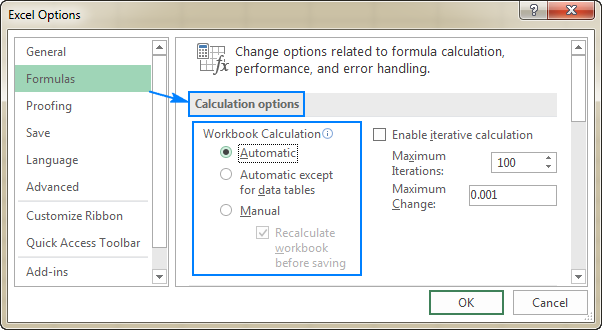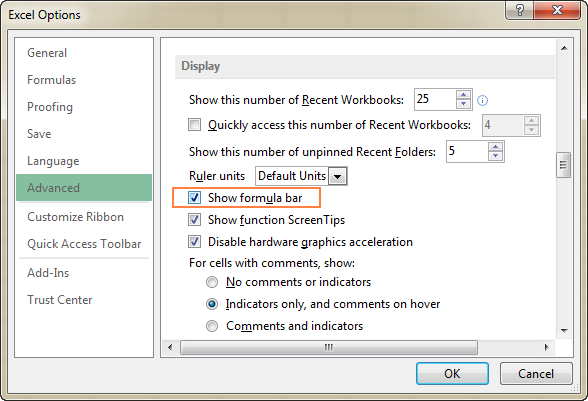
Excel Tools Options Update Automatically Through
There are many details you should know about basic Excel formulas, functions, the order of arithmetic operations, and so on. This will take us to the window from where we can select one or multiple Data analysis tool packs, which can be seen in the Data menu tab.To be able to use Excel formulas efficiently, you need to understand how Microsoft Excel does calculations. Once we get the Excel Options window from Add-Ins, select any of the analysis pack, let’s say Analysis Toolpak and click on Go. To enable the Data Analysis tool in Excel, go to the File menu’s Options tab. Options Excel Options Excel, part of Trader Excel Package, is an option chains and LEAPS series downloader for Microsoft Excel.The tutorial explains the basics of Excel calculation settings and how to configure them to have formulas recalculated automatically and manually.IT Connect is the main portal for technology tools and resources at the UW, including guides to technology options available at the UW, software downloads.But these become active only when you select any of them. Excel Exchange Rates Online Tools - Exchange Rates is a practical tool in which you can update automatically through Internet the currency exchange rates into your Excel spreadsheets.

Excel automatic calculation vs. If left blank, Hyena will attempt to find Excel.exe.Calculation mode - whether Excel formulas are recalculated manually or automatically.Iteration - the number of times a formula is recalculated until a specific numeric condition is met.Precision - the degree of accuracy for a calculation.In this tutorial, we will have a close look at how each of the above settings works and how to change them. On the menu bar you can see Pivot table tools which are marked under different colour.Overall, there are three basic Excel calculations settings you should be familiar with:To customize the locations of these files for special or shared configurations, the following options can be provided on the Tools->Settings->Reporting dialog: Path to Excel.exe - Provide a path to the Excel.exe program, if needed.
However, you are free to alter this behavior and even stop calculation in Excel. When you first open or edit a workbook, Excel automatically recalculates those formulas whose dependent values (cells, values, or names referenced in a formula) have changed. Manual calculation (calculation mode)These options control when and how Excel recalculates formulas.
Selecting the Manual calculation option (either on the ribbon or in Excel Options) automatically checks the Recalculate workbook before saving box. In Excel 2003, click Tools > Options > Calculation > Calculation. In Excel 2007, click Office button > Excel options > Formulas > Workbook Calculation. In Excel 2010, Excel 2013, and Excel 2016, go to File > Options > Formulas > Calculation options section > Workbook Calculation. Open workbooks will be recalculated only when you explicitly do so by using one of these methods.Alternatively, you can change the Excel calculations settings via Excel Options: This option stops automatic recalculation of data tables only, regular Excel tables will still be calculated automatically.Manual - turns off automatic calculation in Excel.
F9 recalculates formulas in all open workbooks, but only those formulas that have changed since the last calculation and formulas dependent on them. Selected the Manual calculation setting, you can force Excel to recalculate by using one of the following methods.To manually recalculate all open worksheets and update all open chart sheets, go to the Formulas tab > Calculation group, and click the Calculate Now button.To recalculate only the active worksheet as well as any charts and chart sheets linked to it, go to the Formulas tab > Calculation group, and click the Calculate Sheet button.Another way to recalculate worksheets manually is by using keyboard shortcuts: If this does not help, check out these troubleshooting steps: Excel formulas not working, not updating, not calculating.If you have turned off Excel automatic calculation, i.e. If all of a sudden your Excel formulas have stopped calculating, go to Calculation Options and make sure the Automatic setting is selected.
Ctrl + Shift + Alt + F9 checks formulas dependent on other cells first, and then recalculates all formulas in all open workbooks, regardless of whether they have changed since the last calculation or not.Microsoft Excel uses iteration (repeated calculation) to compute formulas that refer back to their own cells, which is called circular references. When you have the feeling that some formulas are showing incorrect results, use this shortcut to make sure everything has been recalculated. Ctrl + Alt + F9 forces Excel to recalculate absolutely all formulas in all open workbooks, even those that have not been changed.
In Excel 2016, Excel 2013, and Excel 2010, go to File > Options > Formulas, and select the Enable iterative calculation check box under the Calculation options How to enable and control iterative calculation in ExcelTo turn on Excel iterative calculation, do one of the following: To enable circular references in your worksheets, you must specify how many times you want a formula to recalculate.
In the Maximum Change box, type the maximum amount of change between the recalculated results. The higher the number, the more slowly a worksheet is recalculated. In the Maximum Iterations box, type the maximum number of iterations allowed. In Excel 2003 and earlier, go to Menu> Tools > Options > Calculation tab > Iterative Calculation.To change the number of times your Excel formulas can recalculate, configure the following settings:
No matter how the display value changes, the stored value remains the same (in this example, it's the serial number 42736 that represents Januin the internal Excel system). For example, you can display the same date in a number of ways: , and even Jan-17 depending on what date format you set up for the cell. Before making the change, please be sure you fully understand all possible consequences.In many cases, a value displayed in a cell and the underlying value (stored value) are different. However, you can change this and make Excel use the displayed value instead of the stored value when it recalculates formulas. It means that Excel will stop recalculating your formulas either after 100 iterations or after a less than 0.001 change between iterations, whichever comes first.With all the settings configured, click OK to save the changes and close the Excel Options dialog box.By default, Microsoft Excel calculates formulas and stores the results with 15 significant digits of precision.
If later on you want to calculate with full precision, it won't be possible to restore the original values (5.002 and 5.003).If you have a long chain of dependent formulas (some formulas do intermediate calculations used in other formulas), the final result may become increasingly inaccurate. Then, you add up those numbers, and Excel returns 10.01 because it calculates the stored values (5.002 and 5.003), not the displayed values.Selecting the Precision as displayed option will cause Excel to permanently change stored values to the displayed values, and the above calculation would return 10.00 (5.00 + 5.00). For example, if you enter the number 5.002 in one cell, 5.003 in another cell and choose to display only 2 decimal places in those cells, Microsoft Excel will display 5.00 in both.



 0 kommentar(er)
0 kommentar(er)
